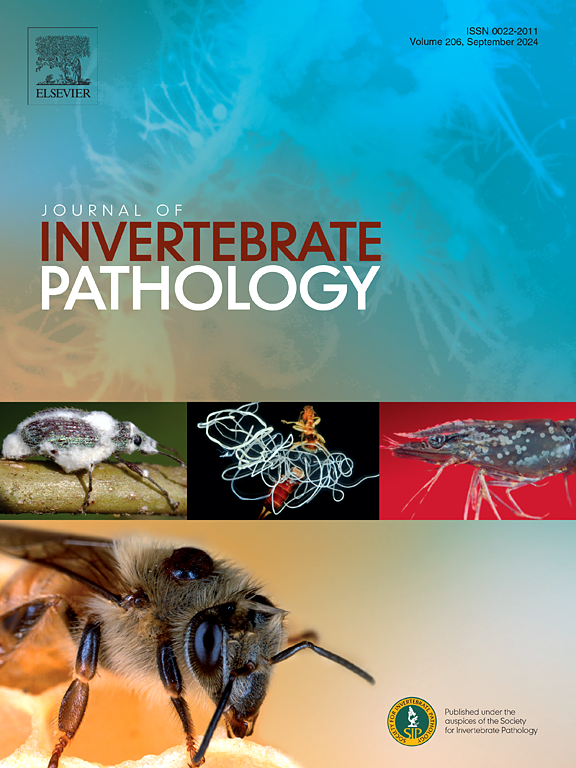韩国一起急性肝胰腺坏死病(AHPND)暴发中分离的Vp AHPND CGVP22的流行病学调查和全基因组分析
IF 2.4
3区 生物学
Q1 ZOOLOGY
引用次数: 0
摘要
由副溶血性弧菌引起的AHPN疾病对全球虾类养殖构成重大威胁。在这里,我们通过全基因组测序(WGS)研究了从韩国平泽市2016年AHPND暴发中分离的AHPND Vp CGVP22的流行病学关系。最初,通过PCR和巢式PCR检测证实了pirAB基因的存在,在AP4巢式PCR中产生了pirA的284个碱基对(bp)和pirB的392 bp的特异条带,以及230 bp的片段。组装的Vp AHPND CGVP22全基因组序列总大小约为5.4 Mbp,由2条圆形染色体(3.4 Mbp和2.0 Mbp)和一个69 kbp的质粒组成。RAST基因组注释鉴定出386个子系统,包括那些与毒力、运动性和铁获取相关的子系统。通过多位点序列分型(MLST)将Vp AHPND CGVP22定位于ST1166序列型,并与来自越南和中国的其他ST1166菌株聚类。对比基因组分析结果显示,Vp AHPND CGVP22与13028/A3相比,存在52个单核苷酸多态性(snp),平均核苷酸同源性(ANI)为99.96 %;与20130629002S01相比,存在973个snp,平均核苷酸同源性(ANI)为99.87 %。vpahpnd CGVP22与13028/A3株pVPA3-1质粒核苷酸同源性为99.94 %,系统发育关系密切。此外,Vp AHPND CGVP22和13028/A3具有相同的噬菌体(12B12)、抗生素抗性基因和毒力因子,而其他ST1166菌株具有不同的特征。总的来说,这些结果为Vp AHPND CGVP22的基因组和进化关系提供了有价值的见解,有助于更好地了解AHPN疾病的流行病学。本文章由计算机程序翻译,如有差异,请以英文原文为准。
Epidemiological investigation and whole genome of Vp AHPND CGVP22 isolated from an acute hepatopancreatic necrosis disease (AHPND) outbreak in Korea
AHPN disease, caused by Vibrio parahaemolyticus, poses a significant threat to global shrimp farming. Here, we investigated the epidemiological relationships of the AHPND- causing Vp AHPND CGVP22, isolated from the 2016 AHPND outbreak in Pyeongtaek, Korea, through whole-genome sequencing (WGS). Initially, the presence of pirAB genes was confirmed by PCR and nested PCR assays, which produced specific bands of 284 base pairs (bp) for pirA and 392 bp for pirB, and a 230 bp fragment in the AP4 nested PCR. The assembled whole-genome sequence of Vp AHPND CGVP22 comprised of a total size of approximately 5.4 Mbp, consisting of 2 circular chromosomes (3.4 Mbp and 2.0 Mbp) and a 69 kbp plasmid. The RAST genome annotation identified 386 subsystems, including those related to virulence, motility, and iron acquisition. In silico multi-locus sequence typing (MLST) assigned Vp AHPND CGVP22 to sequence type ST1166, and clustered with other ST1166 strains from Vietnam and China. Comparative genomic analysis revealed that Vp AHPND CGVP22 exhibited 52 single nucleotide polymorphisms (SNPs) and 99.96 % average nucleotide identity (ANI) relative to the 13028/A3 strain, and 973 SNPs with 99.87 % ANI compared to the 20130629002S01 strain. The plasmid of Vp AHPND CGVP22 showed 99.94 % nucleotide identity to the pVPA3-1 plasmid of the 13028/A3 strain, suggesting a close phylogenetic relationship. Furthermore, Vp AHPND CGVP22 and 13028/A3 shared identical prophages (12B12), antibiotic resistance genes, and virulence factors, while other ST1166 strains exhibit distinct profiles. Collectively, these results provide valuable insights into the genomic and evolutionary relationships of Vp AHPND CGVP22, contributing to a better understanding of the epidemiology of AHPN disease.
求助全文
通过发布文献求助,成功后即可免费获取论文全文。
去求助
来源期刊
CiteScore
6.10
自引率
5.90%
发文量
94
审稿时长
1 months
期刊介绍:
The Journal of Invertebrate Pathology presents original research articles and notes on the induction and pathogenesis of diseases of invertebrates, including the suppression of diseases in beneficial species, and the use of diseases in controlling undesirable species. In addition, the journal publishes the results of physiological, morphological, genetic, immunological and ecological studies as related to the etiologic agents of diseases of invertebrates.
The Journal of Invertebrate Pathology is the adopted journal of the Society for Invertebrate Pathology, and is available to SIP members at a special reduced price.

 求助内容:
求助内容: 应助结果提醒方式:
应助结果提醒方式:


